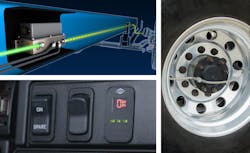There are many risks associated with improper tire inflation, including tire damage, poor fuel economy and unplanned downtime. Experts at Dana explain that tire pressure monitoring systems (TPMS) can help prolong the life of the tires.
Dana (dana.com) is a leader in tire pressure optimization with decades of experience building tire pressure management technology for the U.S. military.
TPMS alerts drivers when one or more tires are under-inflated and could potentially create unsafe driving conditions. TPMS has been around for decades, and vehicles sold in the United States since 2007 include a tire pressure monitoring system of some kind. The ability to detect a potential tire problem and prevent failure provides a major safety and efficiency advantage.
But TPMS doesn’t address the need to adjust the tire pressure, so the operator or fleet manager would still have to manually service the tire. This means that if the TPMS light comes on during the middle of a run, the operator must either take an unscheduled break to refill the tire, or ignore the warning and carry on with an improperly inflated tire - which can lead to damage, downtime and higher replacement costs, defeating the purpose of TPMS.
Dana suggests that an active TPMS could provide a better alternative. Unlike a standard TPMS, which only monitors tire pressure, an active TPMS is able to inflate the tire back to proper pressures when a low pressure is detected. This means that low pressure readings are dealt with automatically, without relying on driver judgement whether to keep driving on low pressure or stop to inflate the tire. Companies that manufacture TPMS, such as Dana, offer a variety of systems that can help fleets effectively monitor their tire pressure, and will work with fleets to determine the best solution for them.
Regardless of your operation, maintaining proper tire inflation is a key aspect of maximizing tire life. TPMS help detect underinflated tires early, giving users time to act before the tire begins wearing prematurely or unevenly.

